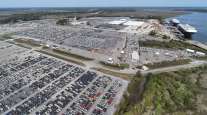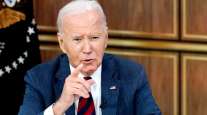Staff Reporter
Federal Funds to Finance Rebuild of Baltimore Bridge
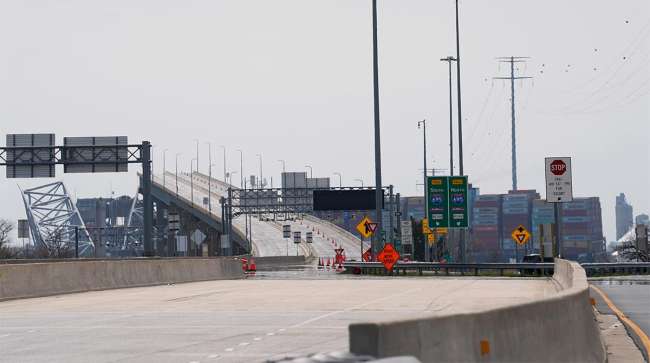
[Stay on top of transportation news: Get TTNews in your inbox.]
U.S. Transportation Secretary Pete Buttigieg reaffirmed the Biden administration’s intention to shoulder federal support and costs to rebuild Baltimore’s collapsed Francis Scott Key Bridge, which is causing supply chain disruptions since it was struck by a cargo ship.
Speaking at a White House briefing March 27 the day after the collapse, Buttigieg revealed the U.S. Department of Transportation is processing a quick release transportation emergency grant to Maryland.
He is holding supply chain meetings to address disruptions caused by the closure to vessel traffic at the Port of Baltimore, which handles $100 million to $200 million of daily cargo.
Distinct efforts will be needed by different leading government agencies, working in coordination, to remedy or replace the broken bridge, reopen the port, investigate the incident and clear the shipping channel of the stricken 200 million-pound vessel with 4,700 containers.
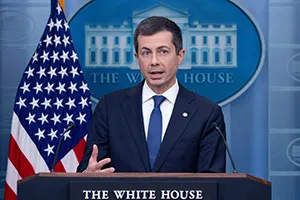
Transportation Secretary Pete Buttigieg says that multiple USDOT agencies will be involved in rebuilding the Francis Scott Key Bridge. (Michael Reynolds/EPA/Bloomberg News)
Buttigieg reiterated that rebuilding the bridge (which also contains part of Interstate 695) will be challenging and expensive.
He earlier pledged help from other USDOT agencies, such as the Maritime Administration, for issues with the port, harbor and supply chain operations, and the Federal Highway Administration, for assistance with the bridge and possible easing of roadway congestion.
President Joe Biden issued a March 26 statement directing relevant federal agencies to reopen the port and rebuild the bridge as soon as possible while supporting Maryland officials with their requests for assistance. A team from the National Transportation Safety Board is investigating the collapse.
“It’s my intention that federal government will pay for the entire cost of reconstructing that bridge,” Biden declared. “We’re going to work with our partners in Congress to make sure the state gets the support it needs.”
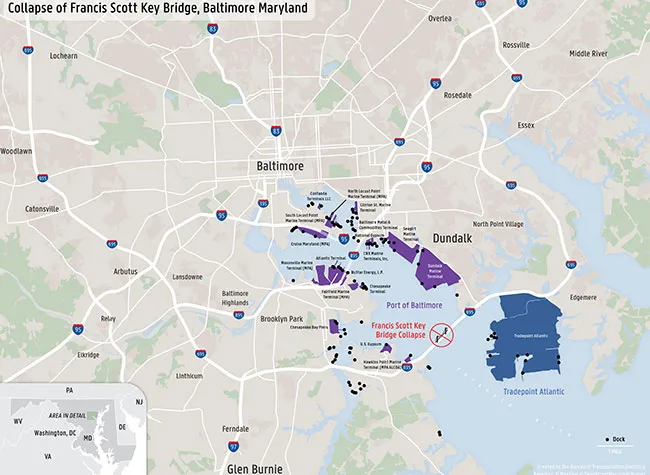
Bureau of Transportation Statistics
Louis Campion, president and CEO of the Maryland Motor Truck Association, told Transport Topics, “The Key Bridge is a critical route for trucking into and out of the Port of Baltimore. Over 1.3 million trucks traverse the bridge each year. The vessel strike and subsequent collapse of the Francis Scott Key Bridge along I-695 is devastating — first in the undetermined lives lost and second in the economic impact to the state of Maryland.”
A swath of Interstate 695 runs across the 1.6-mile bridge that extends over the Patapsco River, where Francis Scott Key was inspired to write “The Star-Spangled Banner,” which became the national anthem.
In effect is a 30-day state of emergency declared by Baltimore Mayor Brandon Scott to address structural and transportation impacts of the collapse. “Our teams are mobilizing resources and working swiftly to address this crisis and ensure the safety and well-being of our community,” Scott said.
Maryland Gov. Wes Moore also declared a state of emergency and noted that state officials are participating “with an interagency team to quickly deploy federal resources from the Biden administration.”
Although vessel traffic is prohibited to/from the Port of Baltimore, the facility remains open. “Trucks are being processed within our marine terminals. At this time, we do not know how long vessel traffic will be suspended. As soon as that is determined we will provide an update,” a port statement read.
Last year, the Port of Baltimore’s state-owned public marine terminals, which are managed by the Maryland Port Administration, and its private terminals handled a record 52.3 million tons of foreign cargo, worth $80 billion.
pic.twitter.com/JkpDusBeCj — The Port of Virginia (@PortofVirginia) March 26, 2024
The Port of Virginia pledged to help. “Our operating team is already working with ocean carriers whose vessels were due to call Baltimore and offering our port’s capability to discharge cargoes as requested,” it said in a statement. “The Port of Virginia has significant experience handling surges of import and export cargo and is ready to provide whatever assistance we can to the team at the Port of Baltimore.”
Similarly, the Port of Philadelphia noted, “The maritime and supply chain community will naturally work to assist the Port of Baltimore in any way at this time.” The Florida Ports Council also offered support.

Campion
Calling the Baltimore port the state’s economic engine, Campion said, “We know that the port itself is responsible for 20,000 direct jobs and thousands of other indirect jobs it creates in industries like trucking.”
He noted the bridge provides the primary Baltimore crossing for hazardous materials carriers, which cannot use the Baltimore tunnels.
“Its collapse also halts the delivery by water of fuel products into the fuel terminals in Curtis Bay. It must be a priority to clear the waterway as expeditiously as possible so that ships can resume cargo deliveries or all industries, including trucking, will suffer,” Campion added.
Traffic diversion, maps and tunnel restrictions updates by the Maryland Transportation Authority are on social media and a special website: mdta.maryland.gov/keybridgenews.
Hazardous materials are prohibited in the tunnels and should use the western section of I-695. This includes vehicles carrying bottled propane gas in excess of 10 lbs per container (maximum of 10 containers), bulk gasoline, explosives, & large amounts of radioactive materials. — Maryland Motor Truck Association (@MDmotorTruck) March 26, 2024
Motorists must avoid the southeast corridor of I-695. Closures are at the I-695 outer loop at Maryland Route 173 on Exit 1 and the inner loop at MD 157/Peninsula Expressway (Exit 43). Harbor crossing alternate routes are I-95 or the I-895 tunnels. Drivers are warned to allow extra travel time using alternative routes on I-95, I-895 and sections of I-695.
Vehicles prohibited to use tunnels to transport hazardous materials (bottled propane gas in excess of 10 pounds per container for no more than 10 containers, bulk gasoline, explosives, significant amounts of radioactive materials) should use the western section of I-695 around tunnels.
Vehicles over 13 feet, 6 inches high or 96 inches wide are prohibited from using the Baltimore Harbor Tunnel. The I-95 Fort McHenry Tunnel restricts vehicles at/above heights of 14 feet, 6 inches and 11 feet wide or greater.
Want more news? Listen to today's daily briefing below or go here for more info:


